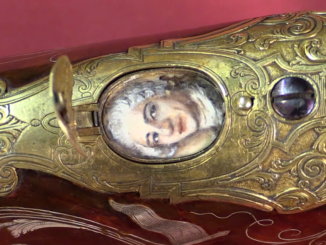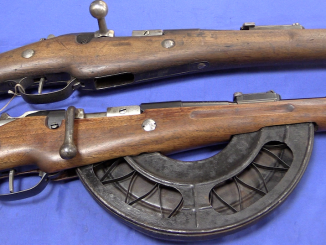Among all the standard rifles that are coming into the US from Ethiopia through InterOrdnance, there are a handful of really unusual oddballs, and we are going to look at several of them. We have the first one today; a single shot adaptation of a French Mle 1878 Marine Kropatschek. Only a small number of these rifles were originally made, part of a contract for the French Navy made by Steyr in Austria. As originally built, the rifle has a 7-round tubular magazine inside the handguard.
This example, however, has been fitted to a stock with no space for a magazine tube. The stock is inletted to fit the rifle’s elevator mechanism, but the elevator goes nowhere, and the system is capable of single shot use only. Why was this done? Perhaps the magazine tube was damaged at some point, and there were no replacement parts available? This is certainly a rare pattern of rifle, and spares would not be likely on hand for an Ethiopian armorer…




Some gun is better than no gun.
And a single shot can often fire the same number of rounds per minute as a tube-fed repeater.
True that. I suspect that the original stock was broken beyond repair. When life gives you limited resources, you do the best that you can with them.
Correct. For those confused-a single-shot rifle and a tube-fed repeating rifle usually don’t have much different in rate of fire. Yes the repeater is, well, a repeater, but since you’re still single-loading the tube, the count is still 1:1. It’s just that a single shot is load 1, fire 1, while a repeater is load 8, fire 8 (etc).
The whole point of early repeaters having magazine cutoffs was that you’d load the tube, flip on the cutoff and use it like a single shot, then flip the cutoff off and empty the tube if the enemy advance got too close (specifically something like cavalry). Once rapid loading systems became commonplace (first the Mannlicher en-bloc, then the stripper clip/charger systems), that tactic became pointless because you could just load 1, fire 5. Much higher RPM.
The nearest thing to a safety on the Kropatschek was that knurled button at the bottom of the loading cutout on the right receiver rail. Slid forward, as here, it locked the lifter in the “up” position, acting as a magazine cutoff. In this case, it probably acts to keep the lifter up as a loading tray.
The position of the rear sight is interesting. As far as I can tell, it’s been brazed in place, and the artificer who did it filed or ground down part of the octagonal breech-end of the barrel to put it there. By simply putting it an inch or so further forward, he would have been spared the effort.
cheers
eon
Y’know… I was always under the impression that when you saw “Marine” in French usage, they were talking about their overseas colonial troops, not the French Navy. Is that an incorrect idea?
The short answer is “all of the above” (it’s complicated).
In French, both the noun and the adjective ‘marine’ refer to the navy, whether it’s the old Marine Royale or the modern Marine Nationale. The original ‘troupes de marine’ were naval infantry: charged with shipboard security, repelling boarders, defense of shore installations, that sort of thing. Their mission expanded over the years until by the late 19th century, they were being used as regular infantry for colonial campaigns. It got to the point where the navy could no longer count on having enough of them available for their original mission, so they stood up a new body as a replacement, the Fusiliers Marins (Naval Riflemen). These are essentially sailors under arms and an organic part of the navy; to this day, they wear naval rates rather than army ranks.
Around the turn of the 20th century, the Third Republic established an independent Ministry of Colonies and the former Troupes de Marine were renamed Troupes Coloniales. Following the Second World War, as France divested herself of the colonies in question, they were renamed Troupes d’Outre-Mer (Overseas Troops) and finally, in the early ‘60s, Troupes de Marine. Part of the regular army, these formations were distinguished by being composed of volunteers rather than conscripts and therefore eligible for overseas deployment.
Sooo… Depends on the timeframe that the weapon was marked, then? Interesting.
In this case, it’s the navy: the Marine Nationale of the Third Republic. These Kropatschek Model 1878 rifles were procured directly by the navy— rather than the civilian Ministry de Marine, which is an important distinction— and were issued to ships as small arms for shore parties and the like. The Troupes de Marine of that era (who had been divorced from the navy proper since the July Monarchy) were equipped with Gras rifles.
Ian,
The customer service at Royal Tiger Imports is horrible. I would suggest checking with the BBB before you let your name be associated with a company like this.
Best Regards,
Chuck Keezer